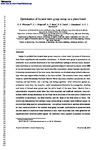Optimisation of focused wave group runup on a plane beach
| dc.contributor.author | Whittaker, CN | |
| dc.contributor.author | Fitzgerald, CJ | |
| dc.contributor.author | Raby, Alison | |
| dc.contributor.author | Taylor, PH | |
| dc.contributor.author | Orszaghova, J | |
| dc.contributor.author | Borthwick, Alistair | |
| dc.date.accessioned | 2017-02-15T18:24:31Z | |
| dc.date.issued | 2017-03 | |
| dc.identifier.issn | 0378-3839 | |
| dc.identifier.issn | 1872-7379 | |
| dc.identifier.other | C | |
| dc.identifier.uri | http://hdl.handle.net/10026.1/8509 | |
| dc.description | publisher: Elsevier articletitle: Optimisation of focused wave group runup on a plane beach journaltitle: Coastal Engineering articlelink: http://dx.doi.org/10.1016/j.coastaleng.2016.12.001 content_type: article copyright: © 2017 Elsevier B.V. All rights reserved. | |
| dc.description.abstract |
Insight is provided into focused wave group runup on a plane beach by means of laboratory wave flume experiments and numerical simulations. A focused wave group is presented as an alternative to an empirical description of the wave conditions leading to extreme runup. Second-order correction to the laboratory wavemaker generation signal is observed to remove about 60% of the sub-harmonic error wave that would otherwise contaminate coastal response experiments. Laboratory measurements of the wave runup time history are obtained using inclined resistance-type wires and copper strips attached to the beach surface. The numerical wave runup model is based on hybrid Boussinesq-Nonlinear Shallow Water equations, empirical parameters for wave breaking and bed friction, and a wetting and drying algorithm. After calibration against experimental runup data, the numerical model reproduces satisfactorily the propagation, shoaling and runup of focused wave groups over the entire length of the wave flume. Results from a comprehensive parametric study show that both measured and predicted maximum runup elevations exhibit strong dependence on the linear focus amplitude of the wave group (linked to its probability of occurrence), the focus location, and the phase of the wave group at focus. The results also demonstrate that extreme runup events owing to focused wave incidence cannot be characterised using spectral parameters alone. The optimal band of focus locations shifts onshore as linear focus amplitude of the incident wave group increases. Optimisation of phase and focus location leads to a maximum runup elevation at each linear amplitude, and, when generated using second-order corrected paddle signals, the maximum runup appears to approach saturation at very large focused wave amplitudes. This study therefore moves beyond simple wave focusing, and presents a focused wave group as a tool for investigating the relationship between extremes within an incident wave field and extreme wave runup. | |
| dc.format.extent | 44-55 | |
| dc.language | en | |
| dc.language.iso | en | |
| dc.publisher | Elsevier BV | |
| dc.subject | Runup | |
| dc.subject | Focused wave groups | |
| dc.subject | Wavemaker theory | |
| dc.subject | Spurious error wave | |
| dc.subject | Boussinesq numerical wave tank | |
| dc.subject | Extreme waves | |
| dc.title | Optimisation of focused wave group runup on a plane beach | |
| dc.type | journal-article | |
| dc.type | Journal Article | |
| plymouth.author-url | https://www.webofscience.com/api/gateway?GWVersion=2&SrcApp=PARTNER_APP&SrcAuth=LinksAMR&KeyUT=WOS:000394475000004&DestLinkType=FullRecord&DestApp=ALL_WOS&UsrCustomerID=11bb513d99f797142bcfeffcc58ea008 | |
| plymouth.volume | 121 | |
| plymouth.publication-status | Published | |
| plymouth.journal | Coastal Engineering | |
| dc.identifier.doi | 10.1016/j.coastaleng.2016.12.001 | |
| plymouth.organisational-group | /Plymouth | |
| plymouth.organisational-group | /Plymouth/Admin Group - REF | |
| plymouth.organisational-group | /Plymouth/Admin Group - REF/REF Admin Group - FoSE | |
| plymouth.organisational-group | /Plymouth/Faculty of Science and Engineering | |
| plymouth.organisational-group | /Plymouth/Faculty of Science and Engineering/School of Engineering, Computing and Mathematics | |
| plymouth.organisational-group | /Plymouth/REF 2021 Researchers by UoA | |
| plymouth.organisational-group | /Plymouth/REF 2021 Researchers by UoA/UoA12 Engineering | |
| plymouth.organisational-group | /Plymouth/Users by role | |
| plymouth.organisational-group | /Plymouth/Users by role/Academics | |
| plymouth.organisational-group | /Plymouth/Users by role/Researchers in ResearchFish submission | |
| dcterms.dateAccepted | 2016-12-12 | |
| dc.rights.embargodate | 2017-12-28 | |
| dc.identifier.eissn | 1872-7379 | |
| dc.rights.embargoperiod | 12 months | |
| rioxxterms.funder | Engineering and Physical Sciences Research Council | |
| rioxxterms.identifier.project | ENFORCE - Extreme responses using NewWave: Forces, Overtopping and Run-up in Coastal Engineering | |
| rioxxterms.versionofrecord | 10.1016/j.coastaleng.2016.12.001 | |
| rioxxterms.licenseref.uri | http://www.rioxx.net/licenses/under-embargo-all-rights-reserved | |
| rioxxterms.licenseref.startdate | 2017-03 | |
| rioxxterms.type | Journal Article/Review | |
| plymouth.funder | ENFORCE - Extreme responses using NewWave: Forces, Overtopping and Run-up in Coastal Engineering::Engineering and Physical Sciences Research Council |


